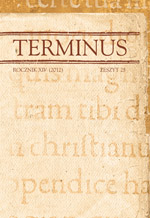Lemmata w staropolskich konstrukcjach stemmatycznych jako przejaw hybrydyzacji gatunkowej
Lemmata in Old-Polish Armorial Poetry as a Manifestation of Genological Hybridization
Author(s): Bartłomiej CzarskiSubject(s): Language and Literature Studies
Published by: Wydawnictwo Uniwersytetu Jagiellońskiego
Summary/Abstract: One of the most popular panegyrical forms in the Polish–Lithuanian Commonwealth was the so-called “stemmata”. Similar to emblems, these visual works consisted of an illustrated coat of arms and an epigram, often attached to the front matter of printed texts during the Old-Polish Period. This article discusses select cases in which, influenced by emblems, lemma are incorporated into the stemmas structure. The text explains how the lemma is introduced to the stemma and how it affects stemmas meaning. Particular attention has been paid to cases in which mottos are treated as the title of a combination of a coat of arms and a poem. The text also analyzes “academic stemmata”, a sub-genre of a heraldic poems that consists of several features characteristic of emblems. The presence of lemma in the structure of stemmata is recognized as the consequence of a trend to liven up this visual form. Making the emblem more attractive was a way to draw the attention of readers, increasing the producer chance of communicating a panegyrical message. Not only the authors of stemma, but also their powerful patrons came to require this effect. The presence of lemma in the structure of heraldic poems also relates to the role of mottos in the Jesuit educational system. Mottos and verba aurea were treated by teachers from Societas Iesu as a very useful medium for presenting moral and parenetic subjects and it was fairly easy for authors of stemmata to use them for panegyric purposes. The lemmas role within the stemmas structure was twofold; it created a special connection between the stemma and the main text and simultaneously linked the fictional word of literature with the real one. The popularity of “classic stemmata” in the Polish-Lithuanian Commonwealth led to the creation and popularization of other hybrid forms composed of a coat of arms and other textual elements.
Journal: TERMINUS
- Issue Year: 14/2012
- Issue No: 25
- Page Range: 157-178
- Page Count: 23
- Language: Polish

